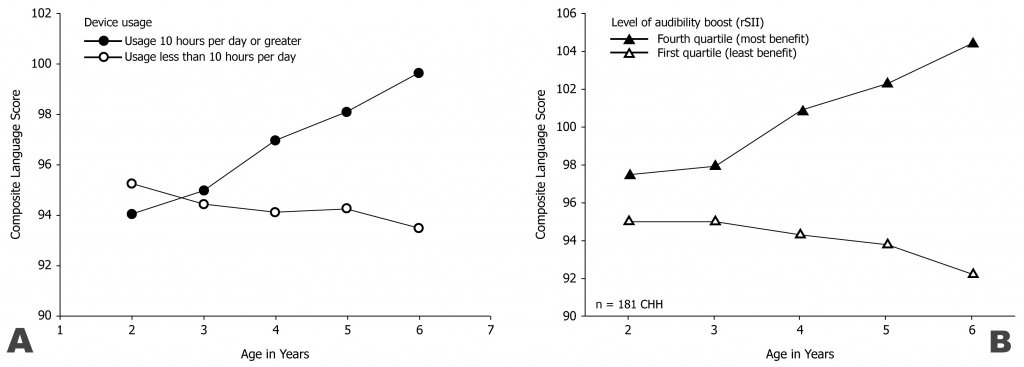Optimizing Outcomes for Children Who are Hard of Hearing
The Impact of Hearing Aids on Language Development
 Congenital hearing loss is the most common health condition that we screen for at birth. Children with hearing loss are at substantial risk for delays across multiple areas, including language, reading, and psychosocial development. These delays can result in significant, persistent educational and vocational gaps. The vast majority of children with hearing loss are considered hard of hearing, with auditory thresholds in the mild to severe range in both ears or mild to profound range unilaterally. Around 90% of children with hearing loss have hearing parents. For children who are hard of hearing who are acquiring spoken language, our most common approach to aural habilitation is through amplification. An accurate picture of how hearing aids support language development in children who are hard of hearing is essential to implementing scientifically-based intervention and counseling for caregivers.
Congenital hearing loss is the most common health condition that we screen for at birth. Children with hearing loss are at substantial risk for delays across multiple areas, including language, reading, and psychosocial development. These delays can result in significant, persistent educational and vocational gaps. The vast majority of children with hearing loss are considered hard of hearing, with auditory thresholds in the mild to severe range in both ears or mild to profound range unilaterally. Around 90% of children with hearing loss have hearing parents. For children who are hard of hearing who are acquiring spoken language, our most common approach to aural habilitation is through amplification. An accurate picture of how hearing aids support language development in children who are hard of hearing is essential to implementing scientifically-based intervention and counseling for caregivers.
Based on findings from the longitudinal, multi-site study, Outcomes of Children with Hearing Loss (OCHL), two factors related to hearing aids have a long-term impact on language outcomes of children who are hard of hearing: the amount of daily hearing aid use and quality of hearing aid fittings. Over time, these factors shape a child’s cumulative auditory experience. Tomblin et al. followed over 300 children with mild to severe hearing loss from preschool to elementary grades on an annual basis.1 All children used spoken English as their primary mode of communication and did not have any additional disabilities. The researchers recorded how often children were wearing their hearing aids at each test visit. Each year, children took part in an extensive battery of vocabulary, grammar, and pragmatic language measures. These scores were combined into a single composite index of language ability. While the average composite score for the children with hearing loss was delayed relative to same-age hearing peers at age 2 years, children who wore hearing aids 10 or more hours per day showed steeper growth in their language skills over four years compared to children who wore hearing aids less than 10 hours per day (Figure 1A). In other words, children who were consistent hearing aid users were able to reduce the language gap between themselves and their peers with typical hearing during the preschool and early elementary years. Importantly, the impact of consistent hearing aid use applies not only to children with moderate or severe hearing loss but also to children with thresholds in the mild range.2–4 Figure 1. Growth in language skills over 4 years.
Figure 1. Growth in language skills over 4 years.
Maximizing outcomes for children with hearing loss does not just involve wearing hearing aids 10 or more hours per day. If hearing aids are not fit appropriately, they can essentially act like earplugs and cause further delays in language development. For amplification to be successful, audiologists must consistently use best practices to ensure that hearing aids match prescriptive targets and increase access to the speech spectrum (also known as audibility). These best practices necessitate the use of hearing aid verification techniques, specifically measuring the aided long-term average speech spectrum either directly in the child’s ear canal (i.e., in situ probe-microphone real-ear measures) or with a coupler in a test box (i.e., simulated real-ear measures, incorporating individual real-ear-to-coupler difference to account for the difference between the 2 cc coupler and the volume of the child’s ear canal). As described in Tomblin et al1 the researchers measured children's aided audibility via real ear or simulated real-ear measures at every visit. At 2 years of age, there was no significant difference in language scores for children who had the largest benefit in audibility from their hearing aids compared to children with the least amount of benefit, after controlling for unaided hearing levels. Over time, however, the children with better-aided audibility made greater progress in their language skills. By age 6, the children with the highest level of aided audibility showed a two-thirds of a standard deviation advantage over the children with the lowest level of aided audibility (Figure 1B). The key point is that the cumulative effect of auditory experience helps children develop stronger language skills over time. Stronger language skills have also been shown to have a positive cascading effect on other domains of development, such as speech recognition in noise, early literacy, and theory of mind.5–7
The positive impact of hearing aids on language development persists into middle childhood (i.e., up to age 12 years). In a recently accepted article, Tomblin et al. found that aided audibility moderated the relationship between unaided hearing levels and language outcomes in elementary-age children who are hard of hearing.8 For children with higher aided audibility (i.e., access to greater than 70% of the speech spectrum), unaided hearing levels did not have a significant association with language scores. Also, children with moderate hearing loss had language scores in the average to above-average range compared to an age-matched group of children with typical hearing. Taken together, these results indicate that for children with mild or moderate hearing loss, aided hearing via hearing aids diminishes the negative effect of decreased unaided hearing on language outcomes. Furthermore, oral language skills serve as an intervening link between unaided hearing and academic outcomes (i.e., reading, writing, and math) in second and fourth grade.
In conclusion, consistent hearing aid use and well-fit hearing aids support learning to listen and listening to learn for children who are hard of hearing. Audiologists and related service providers should be proactive in recommending amplification for children with hearing loss, including children with mild bilateral hearing loss or unilateral hearing loss, rather than operating on a failure-based model.9 Future research is needed to determine whether cumulative auditory experience continues to support language learning efficiency and language growth rates and reduces the risk of educational and vocational gaps for adolescents and young adults with early-onset hearing loss.
References
- Tomblin JB, Harrison M, Ambrose SE, et al. Language outcomes in young children with mild to severe hearing loss. Ear Hearing 2015;36(Suppl. 1):76S–91S. doi:10.1097/AUD.0000000000000219
- McCreery RW, Walker EA, Stiles DJ, et al. Audibility-based hearing aid fitting criteria for children with mild bilateral hearing loss. Language Speech Hear Serv School 2020;51(1):55–67. DOI:10.1044/2019_LSHSS-OCHL-19-0021
- Walker EA, Holte L, McCreery RW, et al. The influence of hearing aid use on outcomes of children with mild hearing loss. J Speech Language Hear Res 2015;58:1611–25. doi:10.1044/2015_JSLHR-H-15-0043
- Walker EA, Sapp C, Dallapiazza M, et al. Language and reading outcomes in fourth-grade children with mild hearing loss compared to age-matched hearing peers. Language Speech Hear Serv School 2020;51(1):17–28. DOI:10.1044/2019_LSHSS-OCHL-19-0015
- Walker EA, Sapp C, Oleson JJ, and McCreery RW. Longitudinal speech recognition in noise in children: effects of hearing status and vocabulary. Frontier Psychol 2019;10:2421–33. doi: 10.3389/fpsyg.2019.02421.
- Tomblin JB, Oleson J, Ambrose SE, et al. Early literacy predictors and second‐grade outcomes in children who are hard of hearing. Child Develop 2018;91:e179–e197.
- Walker EA, Ambrose SE, Oleson J, Moeller MP. False belief development in children who are hard of hearing compared to peers with normal hearing. J Speech, Language Hear Res 2017;60(12):3487–506.
- Tomblin JB, Oleson J, Ambrose SE, et al. Aided hearing moderates the academic outcomes of children with mild to severe hearing loss. Ear Hear 2020; doi: 10.1097/AUD.0000000000000823
- Winiger AM, Alexander JM, and Diefendorf AO. Minimal hearing loss: From a failure-based perspective to evidence-based practice. Am J Audiol 2016;25:232–45.

